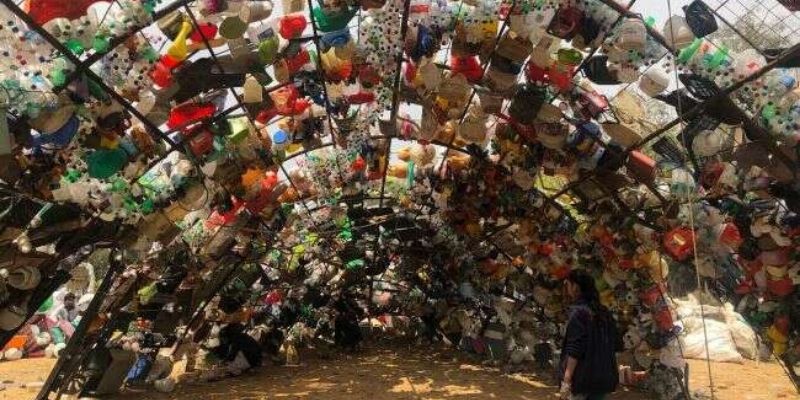Once clogged with sewage, Wazirabad Bundh is creating awareness among people through art made from plastic waste
The 'Where does it go?' campaign in Gurugram aims to show people the mirror on pollution. The art show features a toxic chamber that allows people to experience the waste they generate and also showcases how plastic is a threat to aquatic animals.
According to a study, Indian cities generate 62 million tonnes (MT) of municipal solid waste annually. Unfortunately, only 43 MT of waste is collected, of which 11.9 MT is treated; the remaining 31 MT ends up in landfill sites. This is a serious issue: it pollutes our ground water and has an adverse effect on the health of people living in the neighbourhood.
Mismanagement often means that most of the waste that ends up in landfills is often recyclable. This problem can be solved by segregating waste at source, and with the support of communities. To create this awareness among people, ArtPilgrim Live, an art gallery in Gurugram, Haryana, has initiated a campaign ‘Where does it go?’.
Wazirabad Bundh in Sector 43 of Gurugram, Haryana, was selected for this initiative. Once a barren land and clogged with plastic waste and illegal sewage, Wazirabad Bundh now has 11 structures made from waste, including plastic bags, PET bottles, cans, discarded plastic containers, and e-waste like CD and computer parts. These structures were made in a period of 10 days.
Speaking to NDTV about the initiative, Nidhi Kankan, volunteer at IAmGurgaon, said,
“We tend to throw everything once it is of no use to us. Finished a packet of chips? Toss it in the bin. Have an empty PET bottle? Put it in the garbage. We throw bit by bit and don’t realise the amount of plastic waste we generate in a day, week, or month. The initiative aims at showing people the mirror.”

The Toxic Chamber. Image: NDTV
Each art piece displayed in the park, showcases the importance of waste segregation. For example, ‘the toxic chamber’, an art structure in the form of cave by Arun Kumar, allows people to walk through and experience the waste they have generated.
Apart from the toxic chamber, visitors can also see a structure resembling a fish that has died due to plastic consumption. The art also showcases how plastic is threatening the lives of aquatic animals.

A replica of fish made from plastic waste. Image: NDTV
When asked about the waste generated, Nidhi said,
“Waste has played a major part in giving life to our idea. For the same, we sourced plastic waste and scrap from 10 resident welfare associations (RWAs), 14 schools, and four private offices. We managed to collect 11.5 tonnes of different kinds of waste including plastic, iron, metal, and e-waste.”
Wazirabad Bundh is not only attracting people because it makes people think about the waste they generate, but also for its open green space and clean water tanks. For this, it also received an award for Best Practices to Improve the Living Environment by the Housing and Urban Development Corporation of India (HUDCO), under the Union ministry of Housing and Urban Affairs.
According to the Hindustan Times, Wazirabad Bundh was once clogged with illegal sewage dumping and plastic waste.
With the help of IAmGurgaon, few government agencies like the Forest Department and a private architecture firm, the bundh was revived in a period of four years.

Now, cyclists have dedicated tracks to ride from Wazirabad to Chakkarpur. Image: Hindustan Times
Also read: This 59-year-old bus driver is on a green drive, maintains a mini garden in his bus
The bundh now has 30,000 trees and shrubs, including 30 native species such as amaltas, babool, and pahadi. For water conservation, it has a rainwater harvesting system, which includes recharge chambers, trenches, pits, and perforated pipes to replenish the adjacent water body.
Do you have an interesting story to share? Please write to us at [email protected].To stay updated with more positive news, please connect with us on Facebook and Twitter
Also read: This organisation is fighting climate change, saving wildlife, and generating jobs for tribal people








![[Startup Bharat] Y Combinator-backed BeWell Digital is enabling the digital transformation of radiologists](https://images.yourstory.com/cs/2/40d66ae0f37111eb854989d40ab39087/ImagesFrames31-1648033042143.png)

